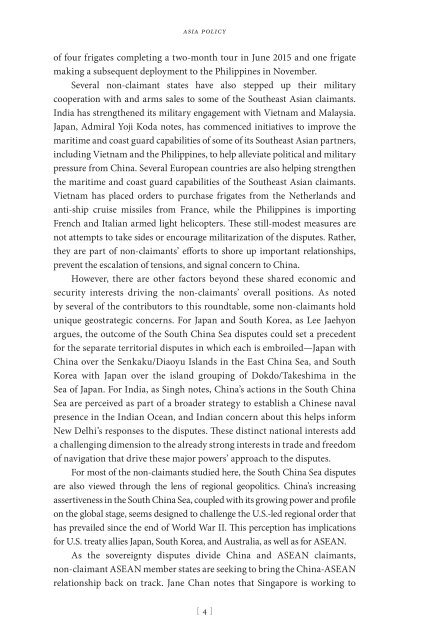You also want an ePaper? Increase the reach of your titles
YUMPU automatically turns print PDFs into web optimized ePapers that Google loves.
asia policy<br />
of four frigates completing a two-month tour in June 2015 and one frigate<br />
making a subsequent deployment to the Philippines in November.<br />
Several non-claimant states have also stepped up their military<br />
cooperation with and arms sales to some of the Southeast Asian claimants.<br />
India has strengthened its military engagement with Vietnam and Malaysia.<br />
Japan, Admiral Yoji Koda notes, has commenced initiatives to improve the<br />
maritime and coast guard capabilities of some of its Southeast Asian partners,<br />
including Vietnam and the Philippines, to help alleviate political and military<br />
pressure from China. Several European countries are also helping strengthen<br />
the maritime and coast guard capabilities of the Southeast Asian claimants.<br />
Vietnam has placed orders to purchase frigates from the Netherlands and<br />
anti-ship cruise missiles from France, while the Philippines is importing<br />
French and Italian armed light helicopters. These still-modest measures are<br />
not attempts to take sides or encourage militarization of the disputes. Rather,<br />
they are part of non-claimants’ efforts to shore up important relationships,<br />
prevent the escalation of tensions, and signal concern to China.<br />
However, there are other factors beyond these shared economic and<br />
security interests driving the non-claimants’ overall positions. As noted<br />
by several of the contributors to this roundtable, some non-claimants hold<br />
unique geostrategic concerns. For Japan and South Korea, as Lee Jaehyon<br />
argues, the outcome of the South China Sea disputes could set a precedent<br />
for the separate territorial disputes in which each is embroiled—Japan with<br />
China over the Senkaku/Diaoyu Islands in the East China Sea, and South<br />
Korea with Japan over the island grouping of Dokdo/Takeshima in the<br />
Sea of Japan. For India, as Singh notes, China’s actions in the South China<br />
Sea are perceived as part of a broader strategy to establish a Chinese naval<br />
presence in the Indian Ocean, and Indian concern about this helps inform<br />
New Delhi’s responses to the disputes. These distinct national interests add<br />
a challenging dimension to the already strong interests in trade and freedom<br />
of navigation that drive these major powers’ approach to the disputes.<br />
For most of the non-claimants studied here, the South China Sea disputes<br />
are also viewed through the lens of regional geopolitics. China’s increasing<br />
assertiveness in the South China Sea, coupled with its growing power and profile<br />
on the global stage, seems designed to challenge the U.S.-led regional order that<br />
has prevailed since the end of World War II. This perception has implications<br />
for U.S. treaty allies Japan, South Korea, and Australia, as well as for ASEAN.<br />
As the sovereignty disputes divide China and ASEAN claimants,<br />
non-claimant ASEAN member states are seeking to bring the China-ASEAN<br />
relationship back on track. Jane Chan notes that Singapore is working to<br />
[ 4 ]


